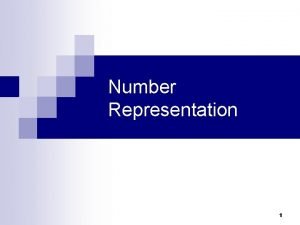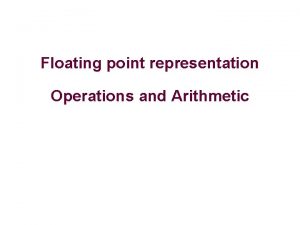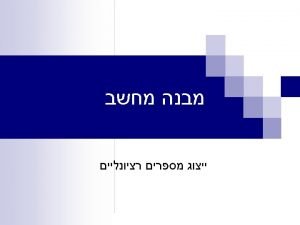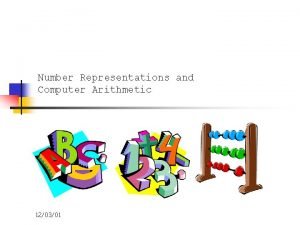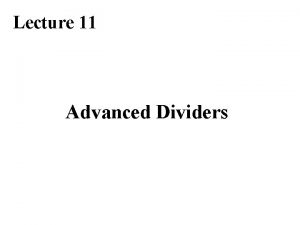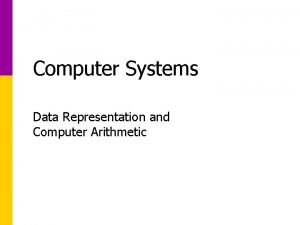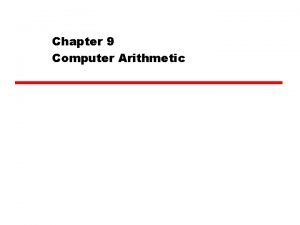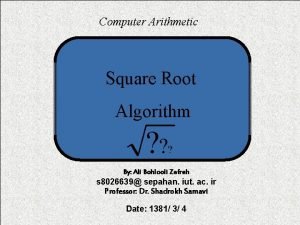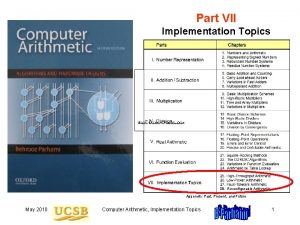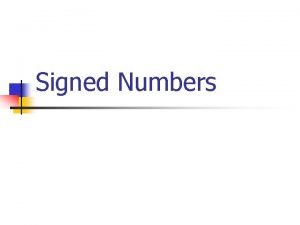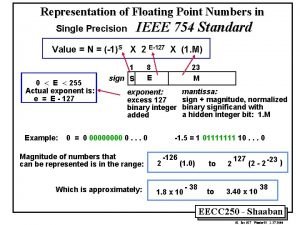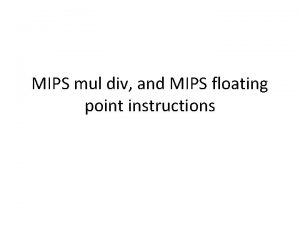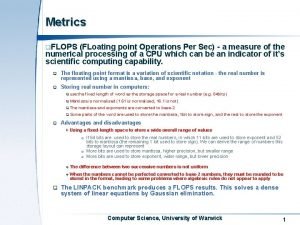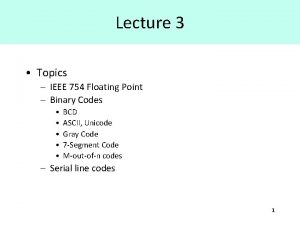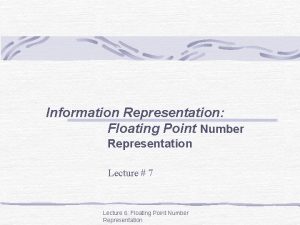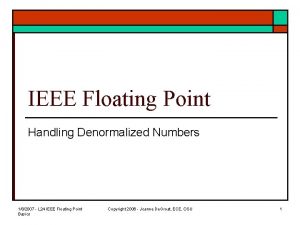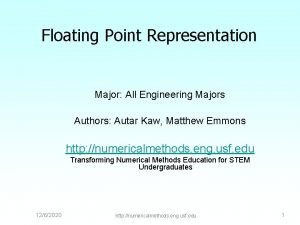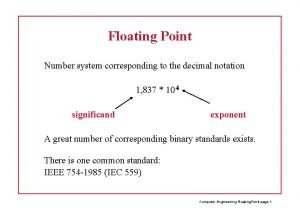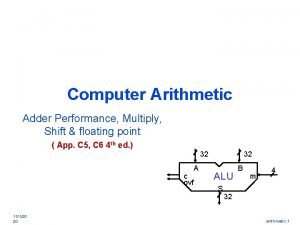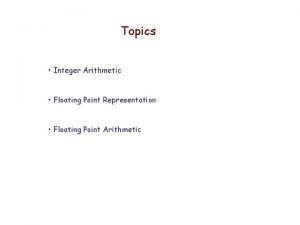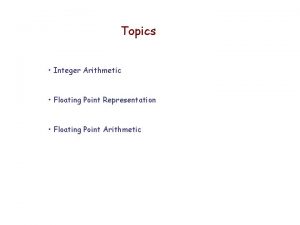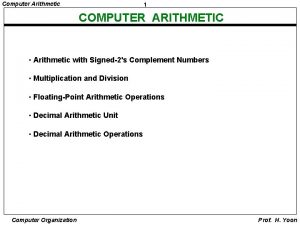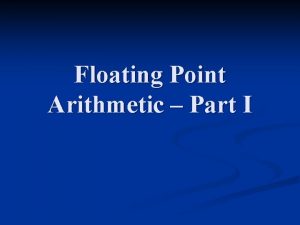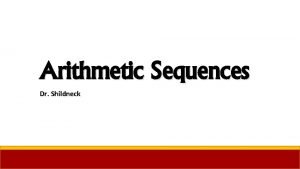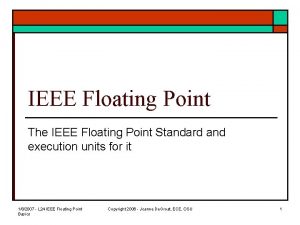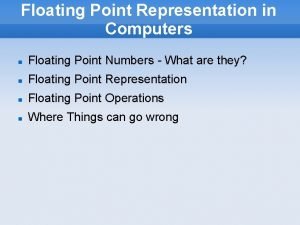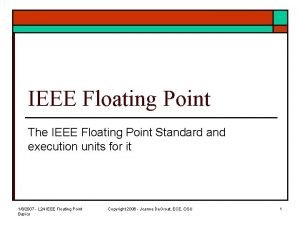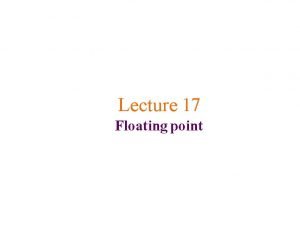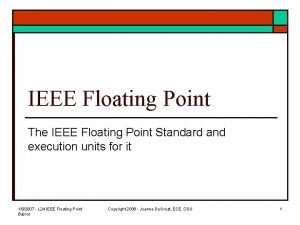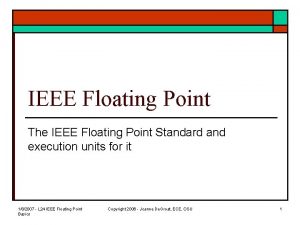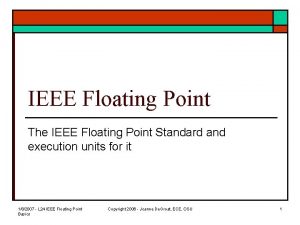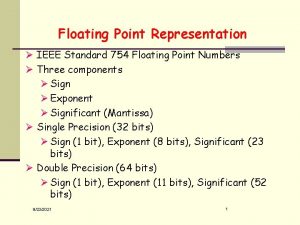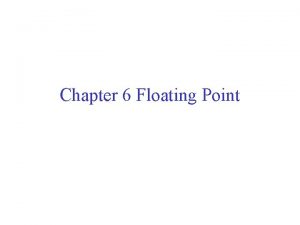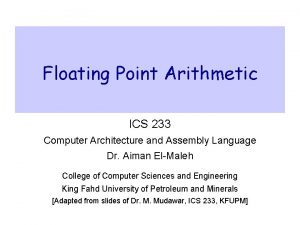Computer Arithmetic Floating Point Floating Point We need






















- Slides: 22

Computer Arithmetic Floating Point

Floating Point • We need a way to represent – numbers with fractions, e. g. , 3. 1416 – very small numbers, e. g. , . 00001 – very large numbers, e. g. , 3. 15576 ´ 109 • Representation: – sign, exponent, significand: (– 1)sign ´ significand ´ 2 exponent – more bits for significand gives more accuracy – more bits for exponent increases range

Definitions • A normalised number has no leading zeros – e. g. 0. 00001 is 1. 0 x 10 -9

1 e. g. 3. 625 ten = 0011. 1010 two 0. 0625 2 0. 125 4 0. 25 8 0. 5 Binary Point

IEEE 754 Floating Point Standard • Single precision: 8 bits exponent, 23 bits significand – 32 bits, C float – range: 2. 0 x 10 -38 to 2. 0 x 1038 S exponent significand • Double precision: 11 bits exponent, 52 bits significand – 64 bits: C double – range: 2. 0 x 10 -308 to 2. 0 x 10308 S exponent significand

Pentium / PPC • Internally, these architectures use an 80 bit floating point representation – defined by IEEE 754 as double-extended – 15 exponent bits – 64 significand bits • CPU converts to double / float when reqd. • 80 -bit format poorly supported by programming languages

Sorting • In an ideal world, the sort operation could use existing (integer) hardware. • Board exercise: In what order do we check the fields of a floating point number when sorting? – -1. 256 x 10 -2 – 0. 234 x 10 -3 – 0. 187 x 101

IEEE 754 Floating Point Standard • Exponent is “biased” to make sorting easier – all 0 s is smallest exponent; all 1 s is largest – bias of 127 for single precision and 1023 for double precision – summary: (– 1)sign ´ (1+significand) ´ 2 exponent – bias • Leading “ 1” bit of significand is implicit • Board Exercise: encode -0. 75 in single precision

IEEE 754 Floating Point Standard • Example: – decimal point: -. 75 = -3/4 = -3/22 – binary point: -0. 11 x 20 = -1. 1 x 2 -1 – floating point exponent = 126 = 01111110 – IEEE single precision: 101111110100000000000

Floating Point Complexities • Mathematical operations are somewhat more complicated • In addition to overflow we can have “underflow” • Accuracy can be a big problem – IEEE 754 keeps two extra bits, guard and round – four rounding modes – positive divided by zero yields “infinity” – zero divided by zero yields “not a number” – other complexities • Implementing the standard can be tricky • Not using the standard can be even worse – see text for description of 80 x 86 and Pentium bug!

Floating Point Addition: Board Exercise • 9. 999 x 101 + 1. 610 x 10 -1 • Assume that we can only store – 4 decimal digits of significand – 2 decimal digits of exponent


Sign Exponent Significand Compare exponents Small ALU Exponent difference 0 1 0 Control 1 0 Shift smaller number right Shift right Big ALU 0 1 0 Increment or decrement Exponent Add 1 Shift left or right Rounding hardware Sign 1 Significand Normalize Round

Floating point Multiplication • Multiply mantissas and add exponents • Steps: – Add exponents – Multiply mantissas – Normalise result – Round results – Fix sign of product


Floating Point Accuracy • Floating point numbers are normally approximations for the numbers they represent – infinite numbers between 0 and 1, but only 53 bits in double precision to represent them • IEEE-754 keeps two extra bits on the right during intermediate calculations called guard and round respectively • Example: add 2. 56 ten * 100 to 2. 34 ten*102 assuming three significant digits – with guard and round digits – without guard and round digits

Sticky Bit • IEEE 754 allows for a third bit in addition to guard and round. • in school we always rounded 0. 5 up – – error accumulates with each round 0. 35 + 0. 4 0. 8 solution: use sticky bit, round down ~half the time 0. 35 + 0. 4 0. 7

Sticky bit example • 5. 01 x 10 -1 + 2. 34 x 102 – Three significant digits

Floating Point Accuracy • Four Rounding modes : – round to nearest (default) – round towards plus infinity – round towards minus infinity – round towards 0

Examples G R S Plus infinity Minus infinity Truncate Nearest even +1001 1 1 0 +1010 +1001 0 1 1 +1010 +1001 1 0 0 +1010 +1001 +1010 +1000 1 0 0 +1001 +1000 +1001 0 0 0 +1001 -1001 1 1 0 -1001 -1010 -1001 0 1 1 -1001 -1010 -1001 1 0 0 -1001 -1010 -1000 1 0 0 -1001 -1000 -1001 0 0 0 -1001

Special Symbols • Special symbols used by IEEE-754 – + or - (largest exponent with 0 mantissa) (result of divide by zero) – Na. N (Not a number) (largest exponent with non 0 mantissa) (0/0 or - ) – Unnormalised Numbers (no explicit 1 in MSB) (0 exponent non-zero mantissa) – Zero (zero Mantissa and zero exponent)

Summary Single Precision Double Precision represents Exponent Significand 0 0 0 Non-zero +/denormalised number 1 -254 Anything 1 -2046 Anything +/- floating point number 255 0 2047 0 +/- infinity 255 Non-zero 2047 Non-zero Na. N (not a number)
 Number system
Number system Fixed point representation
Fixed point representation Floating point division algorithm in computer architecture
Floating point division algorithm in computer architecture Fixed point vs floating point
Fixed point vs floating point Fftooo
Fftooo Computer arithmetic
Computer arithmetic Behrooz parhami computer arithmetic
Behrooz parhami computer arithmetic Data representation and computer arithmetic
Data representation and computer arithmetic Fixed point addition and subtraction flowchart
Fixed point addition and subtraction flowchart Square root algorithm
Square root algorithm Computer organization and architecture william stallings
Computer organization and architecture william stallings Computer arithmetic
Computer arithmetic Why we need computer
Why we need computer Parts of a floating point number
Parts of a floating point number Floating point multiplication flowchart
Floating point multiplication flowchart Mips div instruction
Mips div instruction Floating point operations per seconds
Floating point operations per seconds Floating point single precision
Floating point single precision Floating point number system
Floating point number system Denormalized float
Denormalized float Floating point representation
Floating point representation Floating-point number
Floating-point number Floating point 32 bit
Floating point 32 bit
